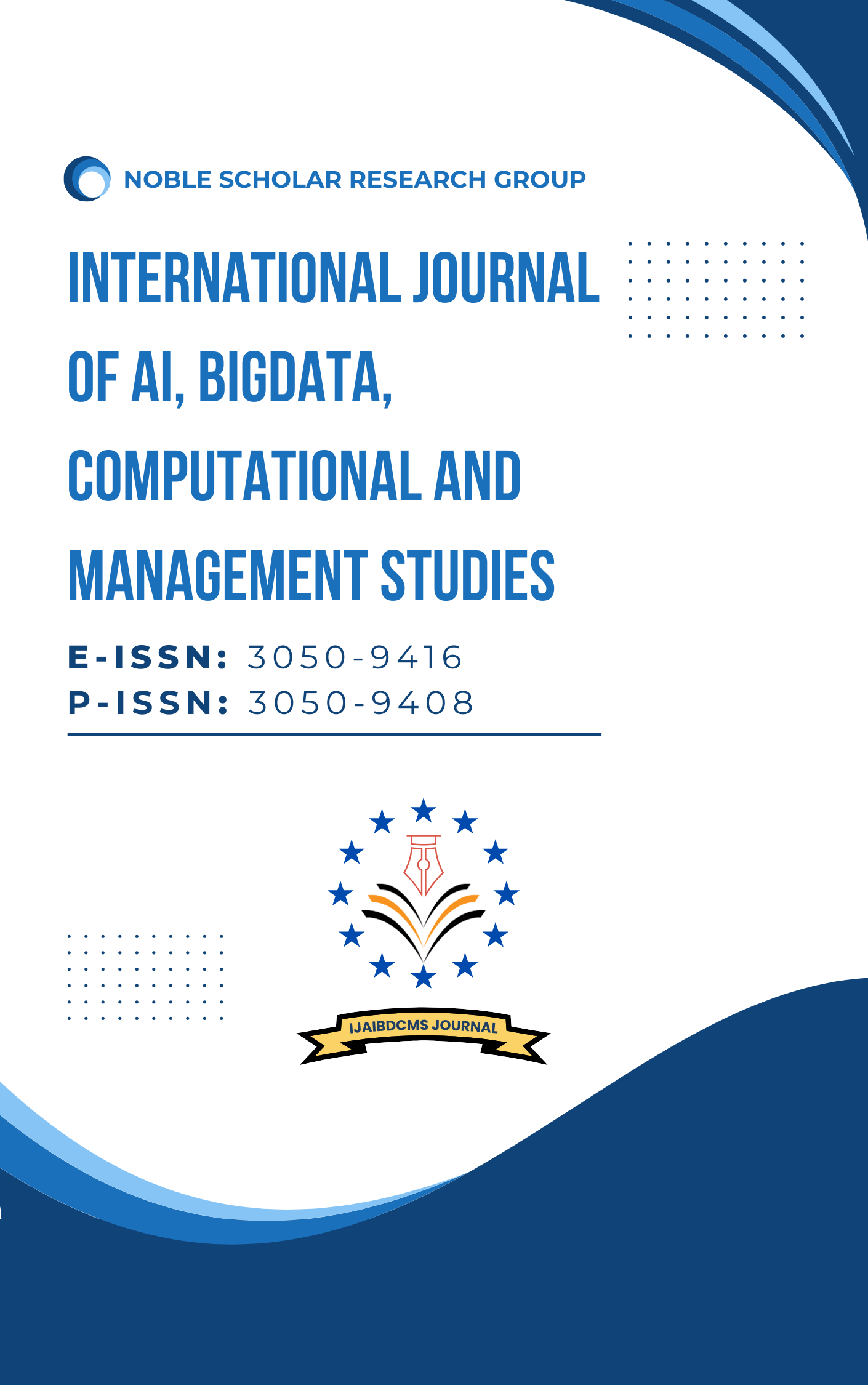Using Oracle Fusion Analytics Warehouse (FAW) and ML to Improve KPI Visibility and Business Outcomes
DOI:
https://doi.org/10.63282/3050-9416.IJAIBDCMS-V3I1P109Keywords:
Oracle FAW, Machine Learning, Embedded ML, ERP, Business Intelligence, Predictive Analytics, Oracle Cloud, Fusion ApplicationsAbstract
One of the most meaningful contributions to the field of analytics is the Machine Learning-based Fusion Analytics Warehouse (FAW) that gives greater understanding of the Key Performance Indicators (KPIs) and makes business far more successful. The current paper is directed at presenting the description of the potential implementation of embedded machine learning and advanced data visualisations in FAW to enable the proactive control of business metrics in Enterprise Resource Planning (ERP) modules. The dynamic business needs real time insights, data based forecasting and prediction. By embedding ML algorithms into the framework of FAW, the potential of predictive analytics and anomaly detection will be unlocked and the strategic planning process will be radically transformed in terms of operational efficiency. This paper debates the theoretical foundation of FAW, articulates methodologies of integrating ML and presents the case studies in the actual implementations with focus on the fields of finance and supply chain and human capital management (HCM). We have demonstrated how interactive dashboards, anomaly detection and self-service analytics can transform classical ERP systems into intelligent, agile and future-ready business systems, with very clearly presented methodology and case studies. Comprehensive literature analysis, a study plan, and a detailed account of findings suggest that the FAW integration with ML is one of the potential ways of attaining digital transformation and competitive advantage
References
1. Chen, H., Chiang, R. H., & Storey, V. C. (2012). Business intelligence and analytics: From big data to big impact. MIS quarterly, 1165-1188.
2. Richardson, J., Sallam, R., Schlegel, K., Kronz, A., & Sun, J. (2020). Magic quadrant for analytics and business intelligence platforms. Gartner ID G, 386610, 00041-5.
3. Wixom, B., & Watson, H. (2010). The BI-based organization. International Journal of Business Intelligence Research (IJBIR), 1(1), 13-28.
4. Azvine, B., Nauck, D., & Ho, C. (2003). Intelligent business analytics—a tool to build decision-support systems for eBusinesses. BT Technology Journal, 21(4), 65-71.
5. Ranjan, J. (2009). Business intelligence: Concepts, components, techniques and benefits. Journal of theoretical and applied information technology, 9(1), 60-70.
6. Wang, Y., Kung, L., & Byrd, T. A. (2018). Big data analytics: Understanding its capabilities and potential benefits for healthcare organizations. Technological forecasting and social change, 126, 3-13.
7. Stefanovic, N. (2014). Proactive supply chain performance management with predictive analytics. The Scientific World Journal, 2014(1), 528917.
8. Raffoni, A., Visani, F., Bartolini, M., & Silvi, R. (2018). Business performance analytics: exploring the potential for performance management systems. Production Planning & Control, 29(1), 51-67.
9. Stackowiak, R., Rayman, J., & Greenwald, R. (2007). Oracle data warehousing & business intelligence Solutions. John Wiley & Sons.
10. Thorström, M. (2017). Applying machine learning to key performance indicators.
11. Volikatla, H., Thomas, J., Bandaru, V. K. R., Gondi, D. S., & Indugu, V. V. R. (2021). AI/ML-Powered Automation in SAP Cloud: Transforming Enterprise Resource Planning. International Journal of Digital Innovation, 2(1).
12. Myles Gilsenan’s 2019 article “Oracle Analytics Cloud and Autonomous Data Warehouse – Better Together” emphasizes the foundational strength of embedded analytics and ML architecture that underpins FAW’s ability to drive insights.
13. Burnay, C., Dargam, F., & Zarate, P. (2019). Data visualization for decision-making: an important issue. Operational Research, 19(4), 853-855.
14. Marjamäki, P. (2017). Evolution and trends of business intelligence systems: a systematic mapping study.
15. Shen-Hsieh, A., & Schindl, M. (2002, April). Data visualization for strategic decision making. In Case studies of the CHI2002| AIGA Experience Design FORUM (pp. 1-17).
16. Dimara, E., Zhang, H., Tory, M., & Franconeri, S. (2021). The unmet data visualization needs of decision makers within organizations. IEEE Transactions on Visualization and Computer Graphics, 28(12), 4101-4112.
17. Reddy, P. V., & Schroeder, C. G. (1999). Data Warehouse Architecture for Army Installations (No. CERLTR9994).
18. Helskyaho, H., Yu, J., & Yu, K. (2021). Oracle Autonomous Database for Machine Learning. In Machine Learning for Oracle Database Professionals: Deploying Model-Driven Applications and Automation Pipelines (pp. 97-133). Berkeley, CA: Apress.
19. Gonugunta, K. C. (2018). Apply Machine Learning Oracle Analytics–Combined. The Computertech, 37-44.
20. Odell, L. A., Farrar-Foley, B. T., Kinkel, J. R., Moorthy, R. S., & Schultz, J. A. (2012). Beyond Enterprise Resource Planning (ERP): The Next Generation Enterprise Resource Planning Environment (No. IDAHQP4852).
21. P. K. Maroju, "Empowering Data-Driven Decision Making: The Role of Self-Service Analytics and Data Analysts in Modern Organization Strategies," International Journal of Innovations in Applied Science and Engineering (IJIASE), vol. 7, Aug. 2021.
22. Pappula, K. K., & Anasuri, S. (2020). A Domain-Specific Language for Automating Feature-Based Part Creation in Parametric CAD. International Journal of Emerging Research in Engineering and Technology, 1(3), 35-44. https://doi.org/10.63282/3050-922X.IJERET-V1I3P105
23. Rahul, N. (2020). Optimizing Claims Reserves and Payments with AI: Predictive Models for Financial Accuracy. International Journal of Emerging Trends in Computer Science and Information Technology, 1(3), 46-55. https://doi.org/10.63282/3050-9246.IJETCSIT-V1I3P106
24. Enjam, G. R. (2020). Ransomware Resilience and Recovery Planning for Insurance Infrastructure. International Journal of AI, BigData, Computational and Management Studies, 1(4), 29-37. https://doi.org/10.63282/3050-9416.IJAIBDCMS-V1I4P104
25. Pappula, K. K., Anasuri, S., & Rusum, G. P. (2021). Building Observability into Full-Stack Systems: Metrics That Matter. International Journal of Emerging Research in Engineering and Technology, 2(4), 48-58. https://doi.org/10.63282/3050-922X.IJERET-V2I4P106
26. Enjam, G. R. (2021). Data Privacy & Encryption Practices in Cloud-Based Guidewire Deployments. International Journal of AI, BigData, Computational and Management Studies, 2(3), 64-73. https://doi.org/10.63282/3050-9416.IJAIBDCMS-V2I3P108
27. Rahul, N. (2021). Strengthening Fraud Prevention with AI in P&C Insurance: Enhancing Cyber Resilience. International Journal of Artificial Intelligence, Data Science, and Machine Learning, 2(1), 43-53. https://doi.org/10.63282/3050-9262.IJAIDSML-V2I1P106



